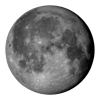Next Full Moon
The next Full Moon will occur on:
That's in
At that exact time the Moon will be at the distance of
The apparent size of the Moon will be
Understanding the Full Moon
A Full Moon occurs when the side of the Moon facing Earth appears 100% illuminated by the Sun. This happens when Earth is positioned roughly between the Sun and the Moon, meaning the Moon is on the opposite side of Earth from the Sun.
Trajectory in the Sky
Because of the geometric configuration with respect to the Sun (also known as "opposition"), a Full Moon rises around sunset, reaches its maximum altitude around midnight, and sets around the time of sunrise.
Another interesting fact about the Full Moon's trajectory in the sky during the 24 hours, is that it roughly follows the Sun's path from the opposite season. This means that in winter the Full Moon will approximately follow the trajectory followed by the Sun during summer and vice-versa. That is why, for instance, full moons in winter reach high altitudes in the sky (as the Sun does during summer) and in summer they remain lower.
Interval Between Full Moons
The interval between two full moons is approximately
Full Moon and Eclipses
A Full Moon can happen when the Moon transits across the shadow of the Earth projected into space. In such a situation a Lunar Eclipse occurs. Lunar eclipses do not happen at every Full Moon because the orbit of the Moon around the Earth is tilted with respect to the orbit of the Earth around the Sun. So, most of the time, a Full Moon passes above or below the shadow of the Earth.
Additional Resources on TheSkyLive
- The Moon: Complete reference information on TheSkyLive.com.
- Today's Moon Phase: Current phase of the Moon, high-resolution image of its present appearance and list of visible features.
- Next Full Moon: Precise date, time and visibility information of the next Full Moon.
- Next New Moon: Precise date, time and additional information about the next New Moon.
- Moon Calendar: Track the phases of the moon for each day.
- Where is the Moon?: Key information on where to find the Moon in the sky.
- Distance of the Moon from Earth: Find out how far the Moon is from Earth right now.
- How Bright is the Moon?: Current visual brightness (magnitude) and apparent size.
- Rise and Set Times: Rise and set times of the Moon from your location.
- Interactive Sky Map: Planetarium-style interactive visualization of the Moon's position in the sky.
- Ephemeris: 15 days the Moon's computed ephemeris.











